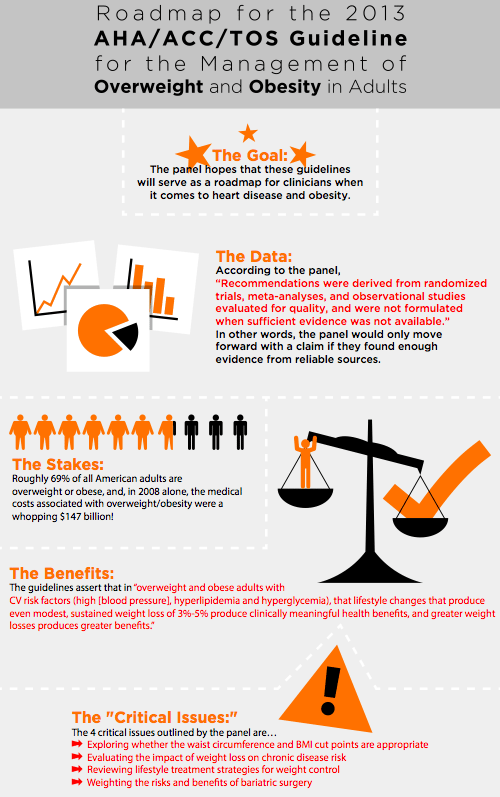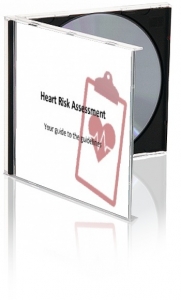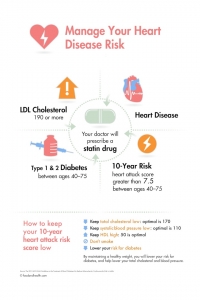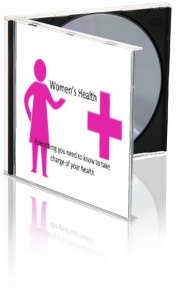5 Things About the New Obesity Guidelines That You Won't Want to Miss
By now, just about everyone has heard about the (somewhat controversial) 2013 ACC/AHA Guideline on the Treatment of Blood Cholesterol to Reduce Atherosclerotic Cardiovascular Risk in Adults. But did you know that the ACC/AHA has released multiple reports on various topics? This week, we're going to take a look at the guidelines for managing obesity, as stated in the 2013 AHA/ACC/TOS Guideline for the Management of Overweight and Obesity in Adults: A Report of the American College of Cardiology/American Heart Association Task Force on Practice Guidelines and The Obesity Society.Wow. That's one long title.Don't worry, it's not as confusing as it looks. In today's post, you can learn all about the basics of the report. In the weeks to come, we'll delve deeper into the keys of both this report and the 2013 ACC/AHA Guideline on the Treatment of Blood Cholesterol to Reduce Atherosclerotic Cardiovascular Risk in Adults.Let's get started!Key #1: The GoalSo, what's the point of these guidelines? The report explains that they were created in order to "develop clinical practice guidelines for assessment of [cardiovascular (CV)] risk, lifestyle modifications to reduce CV risk, and management of blood cholesterol, overweight and obesity in adults." Basically, the panel hopes that these guidelines will serve as a roadmap for clinicians when it comes to heart disease and obesity.Key #2: The DataWe all know that a claim without support is not really worth much, especially when it comes to your health. By the same token, an approach to obesity that doesn't rely on science would not work for these guidelines. According to the panel, "Recommendations were derived from randomized trials, meta-analyses, and observational studies evaluated for quality, and were not formulated when sufficient evidence was not available." In other words, the panel would only move forward with a claim if they found enough evidence from reliable sources.There's lots of support in the community for the research published by the panel. The guidelines affirm, "This document was approved for publication by the governing bodies of the ACC, AHA and The Obesity Society, and endorsed by the American Association of Cardiovascular and Pulmonary Rehabilitation, American Pharmacists Association, American Society for Nutrition, American Society for Preventive Cardiology, American Society of Hypertension, Association of Black Cardiologists, National Lipid Association, Preventive Cardiovascular Nurses Association, The Endocrine Society, and WomenHeart: The National Coalition for Women with Heart Disease (etc)."Key #3: The StakesThe stakes are high on this one. After all, roughly 69% of American adults are either overweight or obese. Approximately 35% are obese. Remember, the guidelines define those conditions as follows, "overweight is defined as a body mass index (BMI) of 25 kg/m2 to 29.9 kg/m2 and obesity as a BMI of >30 kg/m2."Obesity has been linked to a host of diseases and health conditions. The panel asserts, "Overweight and obesity are major contributors to chronic diseases in the United States and present a major public health challenge." Let's let that sink in for a moment. Overweight and obesity are a MAJOR public challenge.The actual monetary cost of obesity is nothing to sneeze at either. According to the guidelines, "It has been reported that, compared with normal weight individuals, obese patients incur 46% increased inpatient costs, 27% more physician visits and outpatient costs, and 80% increased spending on prescription drugs."Key #4: The "Critical Issues"The critical issues of obesity, as laid out by 2013 AHA/ACC/TOS Guideline for the Management of Overweight and Obesity in Adults: A Report of the American College of Cardiology/American Heart Association Task Force on Practice Guidelines and The Obesity Society, are as follows...
- Exploring the appropriateness of the current BMI and waist circumference cutpoints that are used for determining risk in overweight and obese adults across diverse populations.
- Evaluating the impact of weight loss on risk factors for cardiovascular disease (CVD) and type 2 diabetes, as well as CVD morbidity and mortality.
- Reviewing optimal behavioral, dietary intervention strategies, and other lifestyle treatment approaches for weight loss and weight loss maintenance.
- Weighing the benefits and risks of various bariatric surgical procedures.
Key #5: The BenefitsSuccessful weight management has to be important to the patients. Luckily, there are a whole host of benefits that accompany it. According to the guidelines, in "overweight and obese adults with CV risk factors (high [blood pressure], hyperlipidemia and hyperglycemia), that lifestyle changes that produce even modest, sustained weight loss of 3%-5% produce clinically meaningful health benefits, and greater weight losses produces greater benefits."The weight loss described above is likely to result in reduced...
- Blood sugar
- Glycosylated haemoglobin (HbA1C)
- Triglyceride levels
- Type 2 diabetes risk
Further weight loss is likely to result in reduced...
- Blood pressure
- Blood sugar (even further)
- Need for blood pressure medication
- Need for blood sugar medication
- Need for lipid medication
- Triglyceride levels (even further)
Further weight loss has also been linked to improved LDL and HDL cholesterol levels.Want to clear all this up for your clients? Check out the amazing infographic below… Free Infographic: Download the infographic for free today!Free Handout: 5thingsobesity.pdfStay tuned for a comparison of the obesity guidelines and the Dietary Guidelines for Americans!But wait, there's more in the store! We've got some pretty amazing heart education resources, just for you...
Free Infographic: Download the infographic for free today!Free Handout: 5thingsobesity.pdfStay tuned for a comparison of the obesity guidelines and the Dietary Guidelines for Americans!But wait, there's more in the store! We've got some pretty amazing heart education resources, just for you...





